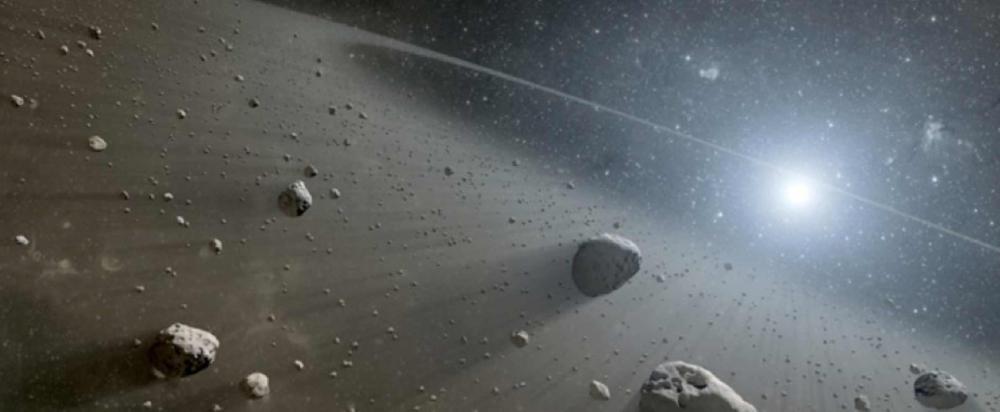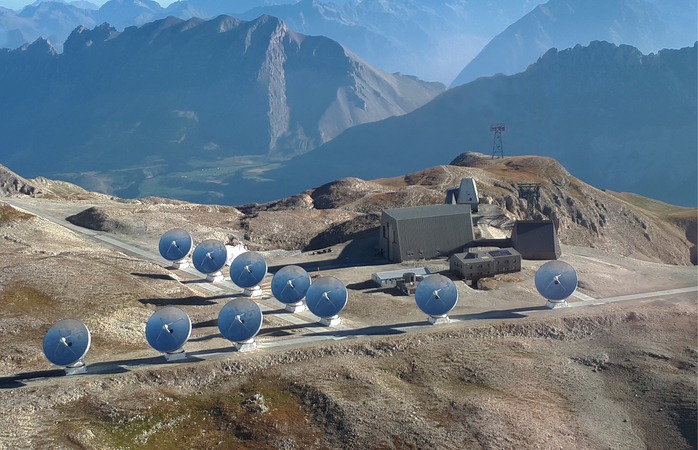An international team led by researchers from the CEA Paris-Saclay Astrophysics Department (DAp) have probed for the first time the dust envelopes surrounding stars in formation (so-called Class 0 protostars) thanks to the large interferometer NOEMA (former Plateau de Bure, France). Surpisingly, the researchers discovered the presence of large grains whose size grows as one gets closer to the central star. The presence of such large grains, already forms a few 10000 years after the beginning of the initial gas collapse is extremely unexpected. These grains are the building blocks from which planets will be formed. These results could thus call for a major revision of the timeline and timescales to form planets. These conclusions are published in Astronomy & Astrophysics.
Cosmic dust, the material to build planets
How do dust grains of the interstellar gas grow to form the building blocks, ultimately forming planets? This question remains a mystery because probing the large envelopes of gas surrounding the future star is non trivial. It requires high-resolution observations. Indeed, even if these disks can reach sizes of several hundred billion kilometers (a few 10000 times the Sun-Earth distance), they are extremely small seen from the Earth (only a few thousandths of a degrees). Moreover, the temperature of the gas is low, requiring observations beyond the infrared, in the so-called (sub)milimeter regime. To detect the dust and probe its physical properties (grain size, temperature, composition), the reserachers studied a sample of 12 forming stars from the CALYPSO sample, thanks to the large NOEMA interferometer (former Plateau de Bure) located in the French Alps.
Dust grains larger than expected
The results show that the dust emissivity index β - which measures the efficiency with which the grain surface emits its thermal energy – is extremely low throughout the envelopes, and decreases as we go to smaller and smaller radii. These low values are a sign of the presence of large (> 100 micrometer size) grains in these young objects and of their steady growth toward the central protostellar disks.
The presence of large grains in young protostars is consistent with theoretical predictions derived from models of polarized dust emission performed by the same team [1]. Recent observations with the ALMA interferometer (ESO-Chile) also suggest that planets could already be present in protoplanetary disks, aged only a million year old. There is hence a thread of hints that the formation of the pebbles, from which planets form, might occur much earlier than previously thought.
That grain growth could have progressed so much in less than 0.1 million years after the onset of the star formation process is still extremely puzzling. These results could call for a revised timeline for planet formation, or at minima severely question our current understanding of how grains evolve from the diffuse regions of the interstellar medium to the planet-forming disks.
The fact that grain growth is already achieved less than 100,000 years after the onset of the star formation process is nevertheless extremely surprising. These results could call for a revised timeline for planet formation, or, at minima, severely question our current understanding of how grains evolve from the diffuse regions of the interstellar medium to the planet-forming disks.

The protostar IRAS 4A. Left: The NGC1333 star forming region observed in infrared with the Spitzer/IRAC instrument. Middle: In the heart of the region, the protostar IRAS 4A observed at 1mm with the Plateau de Bure. Right : Radial variation of the dust emissivity index β of the dust surrounding the IRAS 4A protostar as a function of the distance to the star. The emissivity index decreases as one gets closer to the star, a signature of dust growth. Copyright CEA-DAp.
Contact : Maud GALAMETZ
Publication :
"Low dust emissivities and radial variations in the envelopes of Class 0 protostars: a signature of early grain growth?"
M. Galametz, A. J. Maury, V. Valdivia, L. Testi, A. Belloche, Ph. André
Astronomy & Astrophysics (in press), 2019, see  article in PDF
article in PDF
See also the Arxiv database : https://arxiv.org/abs/1910.04652
This project has received funding from the European Research Council (ERC) under the European Union Horizon 2020 research and innovation programme (MagneticYSOs project, grant agreement N? 679937).
[1] "Indirect evidence of significant grain growth in young protostellar envelopes from polarized dust emission", Valvidia et al . (2019) MNRAS, Vol. 488, Issue 4, p.4897
See also : Embryos of protoplanetary disks much smaller than expected (28 February 2019)
Content : Maud Galametz, Jean-Marc Bonnet-Bidaud
• Structure and evolution of the Universe › Planets, star's formation and dynamics, interstellar medium





